Sig Sauer Mcx Virtus Patrol 556 Nato Msr Review
Every bit I examine the burglarize before me, I observe myself at a flake of an impasse; a case of writer's block, if you volition. How do I describe this new rifle? Is it an AR-15 (unremarkably referred to as a Modern Sporting Rifle—MSR for short) or something entirely unlike? And even if this rifle does bear some strong visual similarity, can information technology be chosen an AR-fifteen? When does a rifle based on the Mod Sporting Rifle terminate being an MSR and plow into something new and different?
SIG Sauer has gone all in with modularity and has had great success with the P320 modular handgun. The P320 tin can be assembled into a total-size, compact or sub-meaty (and in several unlike calibers) without the need for tools or armorer level work. This allows an individual, law enforcement bureau or military unit to configure one pistol to see multiple roles. Now, taking the modularity concept to the rifle earth, SIG Sauer is producing a Mod Sporting Rifle that'due south built around the legacy AR-xv lower receiver. This rifle can be assembled into various configurations, sizes or barrel lengths based on operational or individual needs all while using just the 1 serial numbered lower receiver. 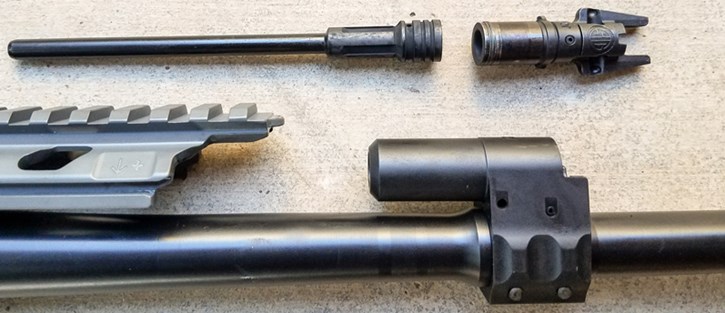
The rifle is the MCX Virtus Patrol, made by SIG Sauer in New Hampshire. It is a semi-automatic burglarize that, from a distance at least, looks just about similar every other MSR on the market. And then, what does the MCX offer that can't be had from a traditional MSR? For starters, the MCX is piston-driven. Piston-operated rifles will generally run longer with less maintenance than their direct impingement cousins. This can particularly exist true when using a audio suppressor. Another benefit is that the MCX's gas system is adaptable and can be somewhat tailored to the ammunition or suppressor being used. This can be quite beneficial when shooting .300 AAC Coma, considering this cartridge tin can be somewhat anemic in subsonic loadings. These light loads can negatively bear upon reliability with their reduced operating pressures, often requiring a larger gas port over what works well for supersonic ammo. Another benefit to the MCX is the relocation of the burglarize's operating springs. Gone is the tubular receiver extension and large action spring found on a traditional AR. Instead, the MCX runs with two minor springs that are located aslope and above the commodities carrier. With the relocation of the activity springs, the rifle can be outfitted with a folding stock for easier send or storage. 
From the modularity standpoint, the MCX's buttstock can be easily swapped out betwixt a folding or sliding stock and the butt and fore-end can be but equally hands changed. The rifle can exist switched from a 16" barreled .223 Rem. with a folding stock to a short-barreled rifle (follow applicative laws) in .300 Blackout with a telescoping stock using nix more than than a Torx wrench. SIG offers several barrel, stock and fore-end options that allow the burglarize to be assembled into whatever number of configurations. Aftermarket companies such equally Midwest Industries, Lancer Systems and Geissele Automatics are producing accessories that might not otherwise be available through SIG Sauer. Cheque with Midwest or Lancer before ordering to verify fitment equally there take been some developmental design changes to the MCX along the mode. 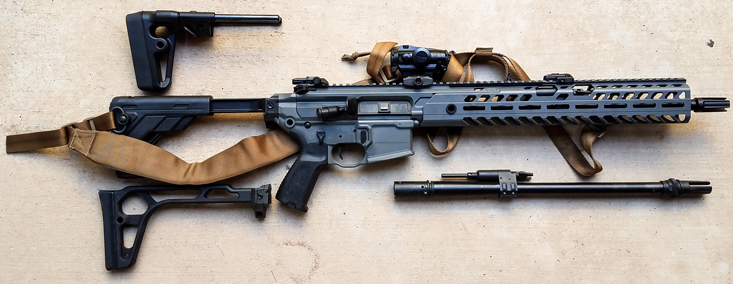
While the MCX is innovative, it actually combines a number of existing ideas that accept been used in one form or some other over the years. The MCX's dual recoil spring organization and short commodities carrier is similar to the bolt and recoil spring assembly used virtually 50 years agone in the ArmaLite AR-18. The folding stock mechanism is close in pattern to what Olympic Artillery, Rock River and ZM Weapons have used on some of their models, and the MCX barrel mounting organization is quite like the system used by LMT. Maybe companies, including SIG Sauer, produce AR-15 rifles that are piston-driven. SIG's innovation lies in the combination of these previous ideas to make what'southward basically a new design while staying inside the parameters of using an existing lower receiver format. This gives the user a rifle with many modern features yet with operating controls and a manual of artillery that is completely familiar. 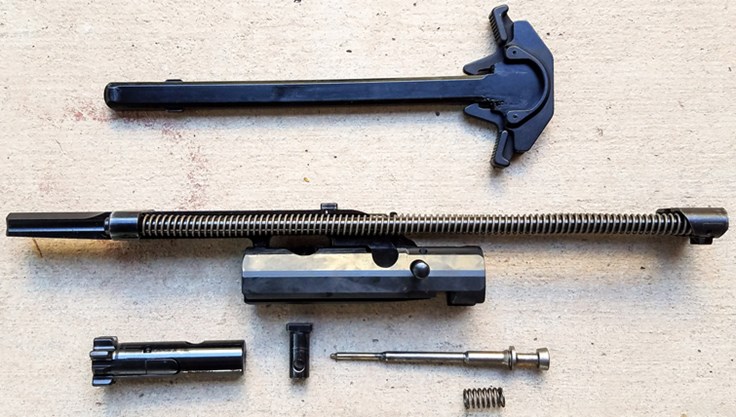
The MCX is going to be immediately comfortable to anyone accustomed to an AR-15. The design parameters are such that the rifle handles and feels familiar and should take fiddling additional practice or training. The one surface area of divergence/difficulty volition be field stripping for maintenance. Given that the bolt carrier is based on, but not interchangeable with, bolt parts from an AR-15, some additional effort will be required before the shooter is completely familiar with the MCX'southward operational parts. The same can exist said for the piston gas system, although neither is a heavy lift and a new owner or user volition be operating at 100 percent with simply a short amount of training or exercise.
On the range, the MCX offered no surprises. By this, I hateful the burglarize met my expectations. It was reliable and accurate, and I had no issues whatsoever over the course of several mean solar day'south use. In that time, I used a multifariousness of .223 Rem. ammunition to include expensive "match course" ammo to inexpensive steel cased blasting ammo to commercial remanufactured provender with no problems. This held true when switching barrels and running the rifle as a .300 Blackout with and without a suppressor. 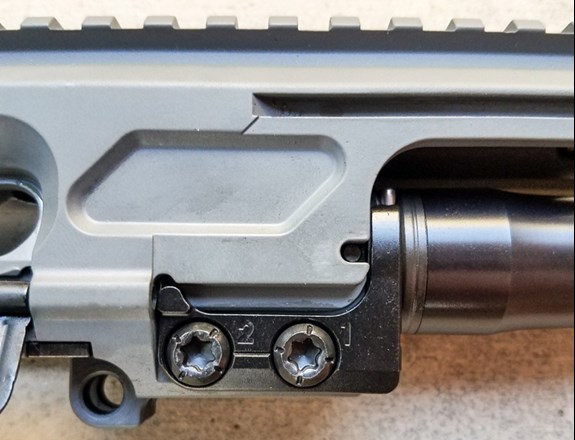
One thing I was concerned about was the rifle's power to maintain zip when pulling the barrel and switching from one caliber to the next. To test this, I fired a v-round grouping from 100 yards. I then pulled and re-mounted the barrel and fired another grouping. I repeated this a total of 5 times and didn't meet more than than an inch or and so change in point of impact on target. 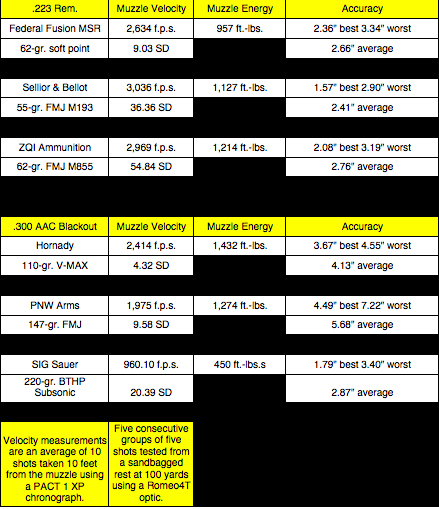
During testing, I used a set of Magpul MBUS Pro folding sights as well as a nifty little scarlet dot optic from SIG Sauer called the Romeo4T. The Romeo4T is both solar and battery powered with an advertised battery life of 100,000 hours. The 4T is unmagnified and features a 2 MOA aiming point at its eye and has four different reticle patterns from which to choose. It is both water and drib resistant and has been approved for use, in a slightly dissimilar version, past both the Federal Agency of Investigation and U.S. Customs and Border Protection. Please notation that the MCX Virtus Patrol does not ship with a sighting system.
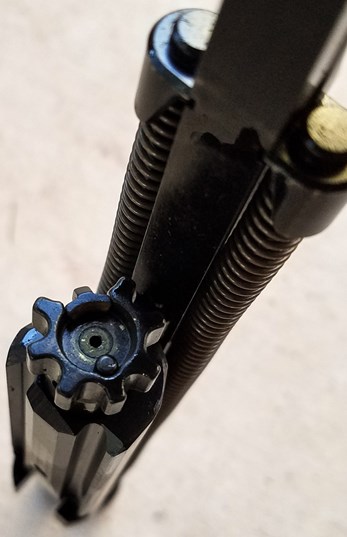
The MCX Virtus Patrol is really a product-improved version of the original MCX that SIG launched at the 2015 SHOT Testify. Every bit originally sold, the MCX used a self-regulating gas piston that was designed to permit just enough gas in for reliable function. Any excessive gas was vented out the front of the piston housing via a leap-loaded valve. This auto-adjusting system was quickly replaced with a manually-adjusted system with two settings. One setting is for suppressed (restricted gas flow) apply while some other setting is for unsuppressed (broad open gas menses) employ. Another change that took identify was the change from a standard AR-15 firing pivot to a firing pin that is locked in identify by a lever. This lever blocks forward firing pin motion and is released by the hammer as information technology travels forward to strike the firing pin. The new bolt was actually function of a safety upgrade enacted by SIG in response to reports of unintentional discharges. The new MCX Virtus Patrol combines the changes mentioned higher up only also now uses a fore-end built to accept MLOK accessories as opposed to the KeyMod system used on the previous version. MLOK has slowly but surely go the industry standard for modular fore-ends. The Virtus barrel profile has also been slightly beefed up to address some accurateness issues with the older model.
SIG is also planning to sell an MCX conversion kit that includes the complete upper and a stock assembly. This means that those who already own a registered full-auto or SBR'd lower can convert this existing firearm to the MCX format and proceeds the benefits of the piston system and folding stock without buying a brand new rifle. Similarly, law departments with inventories of used M16 rifles can convert these old guns to a modern format easily, given the fact that the MCX is designed to piece of work on any standard AR lower.
All in all, the MCX Virtus is a new and interesting take on what's possible with the AR platform. SIG has done an admirable job of tweaking an existing design and pushing it probably well-nigh equally far as it tin go while withal maintaining the familiarity of the firearm on which information technology is based. And so, when does a rifle based on the Modern Sporting Rifle finish beingness an MSR and turn into something new and dissimilar? I recollect SIG Sauer has answered that.
The versatility and adaptability of the MCX are impressive attributes, but they do non come up cheap. Nevertheless, for those who need a rifle with the unique features, or just want something different, the MCX should offer a good value for its premium price.
Specifications:
Manufacturer: SIG Sauer
Model: MCX Virtus Patrol
Caliber: .223 Rem. (also bachelor in .300 BLK)
Action Type: Semi-Automatic
Barrel: 16" Cold Hammer Forged 1X7 Twist
Overall Length: 35.5" with Stock Open up, 26.5" with Stock Closed
Receivers: Aluminum Alloy, Stealth Gray Cease (FDE besides available)
Operation: Short Stroke Gas Piston, 2 Position
Weight: 7.9 lbs. empty
MSRP: $two,233
Source: https://www.americanrifleman.org/content/tested-sig-sauer-mcx-virtus-patrol-rifle/
0 Response to "Sig Sauer Mcx Virtus Patrol 556 Nato Msr Review"
Postar um comentário